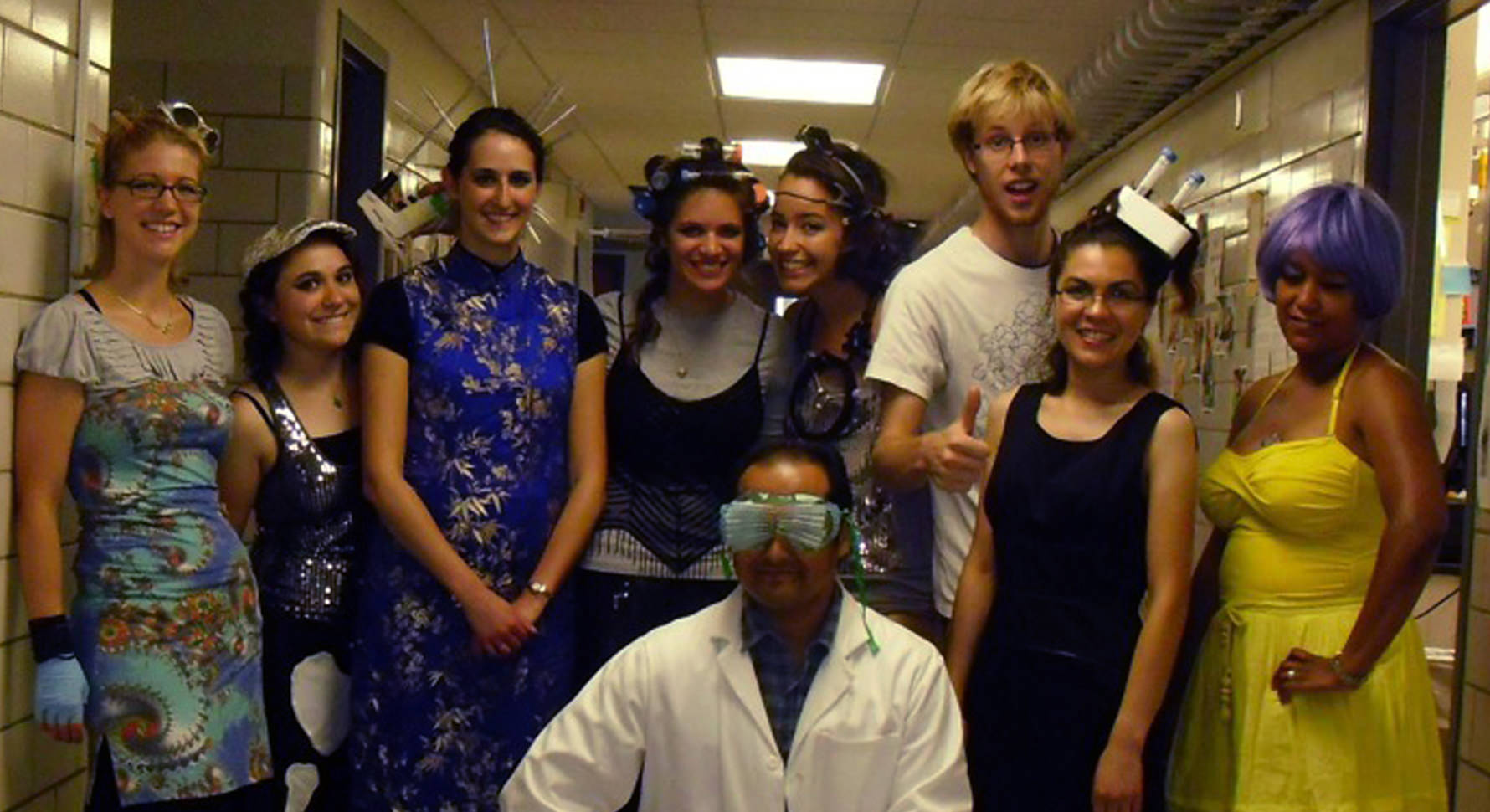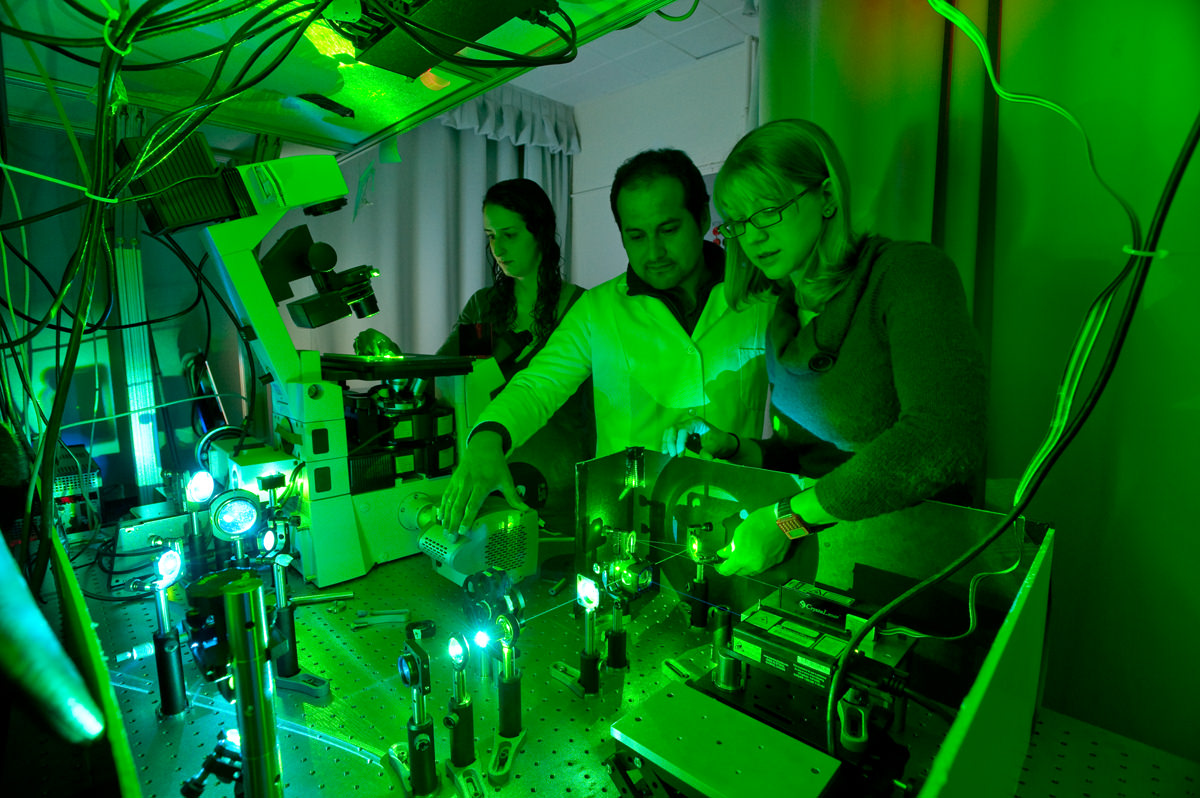There doesn’t seem to be enough time in the day for one-woman show Jennifer Ross to complete all the tasks she has on her plate. From teaching and advising (high school, undergrads, graduate students, and postdocs) to research, to family fun, lab fun (see her lab’s latest science parody videos on YouTube: youtube.com/jennyross13), and an impressive workout of adult gymnastics, readers may be exhausted just thinking about it!
If she knew the course her life would take, would she have done things differently? According to her husband and fellow University of Massachusetts, Amherst, faculty member, Christian Santangelo, she has known her career path since high school. “The blurb she wrote for her picture in the high school year book describes a plan that is eerily similar to her life today,” he says.
Ross, like many other scientists, has always had an interest in science. Ninth grade physical science, described by Ross as a “brilliant hands-on laboratory class,” cemented her interest. After one year at Oberlin College, she transferred to Wellesley College, where she not only earned her undergraduate degree in physics and math, but also organized the first-ever Wellesley Physics vs. Math softball game—a tradition that continues today (the Math department currently holds the trophy)!
Following her undergraduate studies, Ross jumped directly into a graduate program at the University of California, Santa Barbara (UCSB), where she was one of two women in the entering class of 25, (“a big change from Wellesley!” she laughs), and where she would eventually meet Santangelo. In her time at UCSB, Ross focused her physics PhD on biological physics, specifically microtubules and using microscopy to image the dynamics of Taxol binding. “Biological physics seemed very new and open [in 2000],” Ross says. “Of course, now I know that biophysics had already been around for over 50 years!”
Switching coasts again, Ross headed back East for a postdoc at the University of Pennsylvania School of Medicine, working with Yale Goldman and Erika Holzbaur on single molecule studies of cytoplasmic dynein. The skills she acquired during her postdoc have served her well moving forward in her career, as Ross currently specializes in the microtubule cytoskeleton. “I use the single molecule microscopy methods I learned in Dr. Goldman’s lab and the biochemistry and protein purification techniques I learned in Dr. Holzbaur’s lab,” Ross explains.
 Currently, Ross is excited about a new National Science Foundation grant her lab received to study the effects of positive and negative regulators on microtubule dynamic instability. “Microtubule dynamics have been studied for years,” she notes, “but recent research is starting to examine the effects of negative regulators, rather than positive regulators, to help understand how the cell regulates microtubule dynamics.” Moving forward, she would like to continue to work on more and more complex in vitro systems, hoping to one day reconstitute functioning cellular systems.
Currently, Ross is excited about a new National Science Foundation grant her lab received to study the effects of positive and negative regulators on microtubule dynamic instability. “Microtubule dynamics have been studied for years,” she notes, “but recent research is starting to examine the effects of negative regulators, rather than positive regulators, to help understand how the cell regulates microtubule dynamics.” Moving forward, she would like to continue to work on more and more complex in vitro systems, hoping to one day reconstitute functioning cellular systems.
Even with such high hopes, Santangelo and David Sept, University of Michigan, agree that Ross is the woman for the job. “She is highly innovative in designing new methods and approaches to study difficult projects,” explains Sept, who Ross has collaborated with on microtubule mechanics since 2008. Santangelo agrees, saying “Scientifically, she is very clever. She seems to be able to cook up solutions for problems at will.”
This innovation and productivity will be honored during the 57th Annual Meeting of the Biophysical Society, where Ross will receive the Margaret Oakley Dayhoff Award and present her research during the Awards Symposium, taking place on Tuesday, February 5, 10:45 AM–12:45 PM. “I aspired to win the Oakley Dayhoff Award because Sarah Keller, a fellow woman biophysicist, won it several years ago.” Ross admires Keller as having a ‘cool, funky, fun style and attitude,’ saying, “I hope that my work is as respected and remarkable as hers.”
Ross looks forward to the Annual Meeting every year (and not just to be first on the dance floor at the Dessert Reception with David Warshaw!). “As a graduate student, the Meetings gave me a venue to present my work and be seen by famous scientists in my field,” Ross reflected. “During my first poster presentation, Joe Howard came to my poster!” The Society’s inclusion of students has had a big impact on Ross, as she dedicates much of her time to working with students (high school through postdoc), and counts student interactions as among the most rewarding part of her career. “UMass has amazing students,” she brags. “I am especially fond of working with undergraduates, who tend to be fearless about trying crazy new experiments.”
 Beyond the Annual Meeting, Ross also has an appreciation for the Biophysical Journal. “I know it sounds corny,” she says, “but BJ is my home journal! BJ published my very first article ever as a grad student, and my first paper to come totally from my lab was a BJ cover!” She continues, “the reviewers are great, and help make our work better by pushing us to do great science! I hope they publish my last article and many in-between.”
Beyond the Annual Meeting, Ross also has an appreciation for the Biophysical Journal. “I know it sounds corny,” she says, “but BJ is my home journal! BJ published my very first article ever as a grad student, and my first paper to come totally from my lab was a BJ cover!” She continues, “the reviewers are great, and help make our work better by pushing us to do great science! I hope they publish my last article and many in-between.”
It may sound amazing that Ross has any time beyond her mentoring and publishing activities, award-winning research, and YouTube video creation, but she finds the time. Outside of the lab, Ross hangs out with her young family—her husband and their six-year old daughter and four-month old son. She also participates in an adult gymnastics class, getting back to the sport years after being knocked out of Level Nine (out of ten levels) competition by an injury.
With all of her work with students at every level, Ross has many pieces of advice to share with young biophysicists. “Some advice I used, some advice I wish I had used,” she says. Her number one tip is to immerse yourself in the literature. “The most impressive people are usually the most well-read,” she explains. “It may take time, but it will be worth it.” For more career tips from Ross, check out the latest Dear Molly Cule article on the Biophysical Society blog at https://biophysicalsociety.wordpress.com/2013/02/01/dear-molly-cule-advice-from-bps-profilee/.